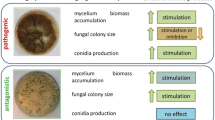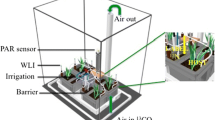Abstract
Humic substances (HS) represent the major reservoir of carbon (C) in ecosystems, and their turnover is crucial for understanding the global C cycle. Although basidiomycetes clearly have a role in HS degradation, much less is known about the effect of HS on fungal traits. We studied the alteration of physiological, biochemical, and morphological characteristics of Trametes maxima in the presence of HS. Both complete medium and minimal (C-limited) medium mimicking natural environmental conditions were used. Adding HS led to increased biomass yield, but under C-limited conditions the effect was more apparent. This result indicated that HS were used as an additional substrate and agreed with data showing a greater penetration of tritium-labeled HS into the cell interior under C-limited conditions. Humic substances induced ultra-structural changes in fungal cells, especially under C limitation, including reducing the thicknesses of the hyphal sheath and cell wall. In the minimal medium, cellular respiration increased nearly three-fold under HS application, while the corresponding effect in complete medium was lower. In addition, in the presence of inhibitors, HS stimulated either the cytochrome or the alternative pathway of respiration, depending on presence or absence of glucose in the medium. Our results suggest that, under conditions mimicking the natural environment, HS may play three major roles: as a surplus substrate for fungal growth, as a factor positively affecting cell morphology, and as an activator of physiological respiration.




Similar content being viewed by others
References
Angelova MB, Pashova SB, Spasova BK, Vassilev SV, Slokoska LS (2005) Oxidative Stress Response of Filamentous Fungi Induced by Hydrogen Peroxide and Paraquat. Mycol Res 109:150–158. doi:10.1017/S0953756204001352
Badun GA, Chernysheva MG, Tyasto ZA, Kulikova NA, Kudryavtsev AV, Perminova IV (2010) A new Technique for Tritium Labeling of Humic Substances. Radiochim Acta 98:161–166. doi:10.1524/ract.2010.1695
Bahr JT, Bonner WD (1973) Cyanide-Insensitive Respiration. 1. Steady States of Skunk Cabbage Spadix and Bean Hypocotyl Mitochondria. J Biol Chem 248:3441–3445
Belcarz A, Ginalska G, Kornillowicz-Kowalska T (2005) Extracellular Enzyme Activities of Bjerkandera Adusta R59 Soil Strain, Capable of Daunomycin and Humic Acids Degradation. Appl Microbiol Biotechnol 68:686–694. doi:10.1007/s00253-005-1918-1
Boufalis A, Pellissier F (1994) Allelopathic Effects of Phenolic Mixtures on Respiration of two Spruce Mycorrhizal Fungi. J Chem Ecol 20:2283–2289. doi:10.1007/BF02033203
Chae MS, Nargang FE (2009) Investigation of Regulatory Factors Required for Alternative Oxidase Production in Neurospora Crassa. Physiol Plant 137:407–418. doi:10.1111/j.1399-3054.2009.01239.x
Chen C, Ko Y, Delannoy M, Ludtke SJ, Chiu W, Pedersen PL (2004) Mitochondrial ATP Synthasome: Three-Dimensional Structure by Electron Microscopy of the ATP Synthase in Complex Formation With Carriers for Pi and ADP/ATP. J Biol Chem 279:31761–31768. doi:10.1074/jbc.M401353200
Corrales Escobosa AR, Landero Figueroa JA, Gutierrez Corona JF, Wrobel K (2009) Effect of Fusarium Oxysporum f. sp. Lycopersici on the Degradation of Humic Acid Associated With Cu, Pb, and Ni: An in Vitro Study. Analyt Bioanalyt Chem 394:2267–2276. doi:10.1007/s00216-009-2894-6
Cui YQ, Okkerse WY, Van der Lans RGJM, Luyben KCAM (1998) Modeling and Measurements of Fungal Growth and Morphology in Submerged Fermentations. Biotechnol Bioeng 60:216–229. doi:10.1002/(SICI)1097-0290(19981020)60:2<216::aid-bit9>3.0.co;2-q
Dehorter B, Blondeau R (1992) Extracellular Enzyme Activities During Humic Acid Degradation by the White rot Fungi Phanerochaete Chrysosporium and Trametes Versicolor. FEMS Microbiol Let 94:209–215. doi:10.1111/j.1574-6968.1992.tb05320.x
Fakoussa RM, Frost PJ (1999) In Vivo-Decolorization of Coal-Derived Humic Acids by Laccase-Excreting Fungus Trametes Versicolor. Appl Microbiol Biotechnol 52:60–65. doi:10.1007/s002530051487
Ferretti AC, Larocca MC, Favre C (2012) Nutritional Stress in Eukaryotic Cells: Oxidative Species and Regulation of Survival in Time of Scarceness. Mol Genet Metab 105(2):186–192. doi:10.1016/j.ymgme.2011.11.007
Gramss G, Ziegenhagen C, Sorge S (1999) Degradation of Soil Humic Extract by Wood- and Soil-Associated Fungi, Bacteria, and Commercial Enzymes. Microbial Ecol 37:140–151. doi:10.1007/s002489900138
Green F, Glausen CA, Larsen MJ, Highley TL (1992) Immuno-Scanning Electron Microscopic Localization of Extracellular Wood-Degrading Enzymes Within the Fibrillar Sheath of the Brown-rot Fungus Postia Placenta. Can J Microbiol 38:898–904. doi:10.1139/m92-146
Grindler M, Hrselova H, Sudova R, Grindlerova H, Rezacova V, Merhautova V (2005) Hyphal Growth and Micorrhyza Formation by the Arbuscular Micorrhizal Fungus Glomus Claroideum BEG 23 is Stimulated by Humic Substances. Mycorrhiza 15:483–488. doi:10.1007/s00572-005-0352-7
Grinhut T, Hadar Y, Chen Y (2007) Degradation and Transformation of Humic Substances by Saprotrophic Fungi: Processes and Mechanisms. Fungal Biol Rev 21:179–189. doi:10.1016/j.fbr.2007.09.003
Grinhut T, Hertkorn N, Schmitt-Kopplin P, Hadar Y, Chen Y (2011a) Mechanisms of Humic Acids Degradation by White rot Fungi Explored Using H-1 NMR Spectroscopy and FTICR Mass Spectrometry. Environ Sci Technol 45:2748–2754. doi:10.1021/es1036139
Grinhut T, Salame TM, Chen YN, Hadar Y (2011b) Involvement of Ligninolytic Enzymes and Fenton-Like Reaction in Humic Acid Degradation by Trametes sp. Appl Microbiol Biotechnol 91:1131–1140. doi:10.1007/s00253-011-3300-9
Gutiérrez-Soto JG, Salcedo-Martínez SM, Contreras-Cordero JF, Hernández-Luna CE (2011) Characterization of the Major Laccase from Trametes Maxima CU1 and Decolorization of Nine Commercially Significant Dyes by the Enzyme. Water Research & Development 1:10–19
Hwang CS, Baek YU, Yim HS, Kang SO (2003) Protective Roles of Mitochondrial Manganese-Containing Superoxide Dismutase Against Various Stresses in Candida Albicans. Yeast 20:929–941. doi:10.1002/yea.1004
Juárez O, Guerra G, Martínez F, Pardo JP (2004) The Mitochondrial Respiratory Chain of Ustilago Maydis. BBA-Bioenergetics 1658:244–251. doi:10.1016/j.bbabio.2004.06.005
Klein OI, Kulikova NA, Konstantinov AI, Fedorova TV, Landesman EO, Koroleva OV (2013) Transformation of Humic Substances of Highly Oxidized Brown Coal by Basidiomycetes Trametes Hirsuta and Trametes Maxima. Appl Biochem Microbiol 49:287–295. doi:10.1134/S0003683813030101
Kluczek-Turpeinen B, Maijala P, Tuomela M, Hofrichter M, Hatakka A (2005) Endoglucanase Activity of Compost-Dwelling Fungus Paecilomyces Inflatus is Stimulated by Humic Acids and Other low Molecular Mass Aromatics. World J Microbiol Biotechnol 21:1603–1609. doi:10.1007/s11274-005-8291-1
Ko YH, Delannoy M, Hullihen J, Chiu W, Pedersen PL (2003) Mitochondrial ATP Synthasome Cristae-Enriched Membranes and a Multiwell Detergent Screening Assay Yield Dispersed Single Complexes Containing the ATP Synthase and Carriers for Pi and ADP/ATP. J Biol Chem 278:12305–12309. doi:10.1074/jbc.M200703200
Kornillowicz-Kowalska T, Ginalska G, Belcarz A, Iglik H (2008) Decolorization of Humic Acids and Alkaline Lignin Derivative by an Anamorphic Bjerkandera Adusta R59 Strain Isolated from Soil. Pol J Environ Stud 17:903–909
Koroleva-Skorobogat’ko O, Stepanova E, Gavrilova V, Morozova O, Lubimova N, Dzchafarova A, Yaropolov A, Makower A (1998) Purification and Characterization of the Constitutive Form of Laccase from the Basidiomycete Coriolus Hirsutus and Effect of Inducers on Laccase Synthesis. Bioteсhnol Appl Biochem 28:47–54
Kudryavtsev AV, Perminova IV, Petrosyan VS (2000) Size-Exclusion Chromatographic Descriptors of Humic Substances. Anal Chim Acta 407:193–202. doi:10.1016/S0003-2670(99)00814-4
Kulikova NA, Perminova IV, Badun GA, Chernysheva MG, Koroleva OV, Tsvetkova EA (2010) Estimation of Uptake of Humic Substances from Different Sources by Escherichia Coli Cells Under Optimum and Salt Stress Conditions by use of Tritium-Labeled Humic Materials. Appl Environ Microbiol 76:6223–6230. doi:10.1128/AEM.00905-10
Li Q, Bai Z, O'donnell A, Harvey LM, Hoskisson PA, McNeil B (2011) Oxidative Stress in Fungal Fermentation Processes: The Roles of Alternative Respiration. Biotechnol Lett 33:457–467. doi:10.1007/s10529-010-0471-x
Magnani T, Soriani FM, Martins VP, Policarpo AC, Sorgi CA, Faccioli LH, Curti C, Uyemura SA (2007) Silencing of Mitochondrial Alternative Oxidase Gene of Aspergillus Fumigatus Enhances Reactive Oxygen Species Production and Killing of the Fungus by Macrophages. J Bioenerg Biomembr 40:631–636. doi:10.1007/s10863-008-9191-5
Martins VP, Dinamarco TM, Soriani FM, Tudella VG, Oliveira SC, Goldman GH, Curti C, Uyemura SA (2010) Involvement of an Alternative Oxidase in Oxidative Stress and Mycelium-to-Yeast Differentiation in Paracoccidioides Brasiliensis. Eukaryotic Cell 10:237–481. doi:10.1128/EC.00194-10
Martins VP, Dinamarco TM, Uyemura SA, Curti C (2011) Classical and Alternative Components of the Mitochondrial Respiratory Chain in Pathogenic Fungi as Potential Therapeutic Targets. J Bioenerg Biomembr 43:81–88. doi:10.1007/s10863-011-9331-1
Matrosova EV, Mazheika IS, Kudriavtseva OA, Kamzolkina OV (2009) Morphogenesis and Ultrastructure of Basidiomycetes Agaricus and Pleurotus Mitochondria. Tsitologiia 51:490–499
Maxwell DP, Wang Y, Mcintosh L (1999) The Alternative Oxidase Lowers Mitochondrial Reactive Oxygen Production in Plant Cells. Proc Natl Acad Sci U S A 6:8271–8276. doi:10.1073/pnas.96.14.8271
Medentsev AG, Arinbasarova AY, Akimenko VK (1999) Regulation and physiological role of cyanide-resistant oxidases in fungi and plants. Biochemistry-Moscow + 64:1230–1243
Minagawa N, Koga S, Nakano M, Sakajo S, Yoshimoto A (1992) Possible Involvement of Superoxide Anion in the Induction of Cyanide-Resistant Respiration in Hansenula Anomala. FEBS Lett 302:217–219. doi:10.1016/0014-5793(92)80444-L
Moller IM (2001) Plant Mitochondria and Oxidative Stress: Electron Transport, NADPH Turnover, and Metabolism of Reactive Oxygen Species. Annu Rev Plant Physiol Plant Mol Biol 52:561–591. doi:10.1146/annurev.arplant.52.1.561
Papagianni M (2004) Fungal Morphology and Metabolite Production in Submerged Mycelial Processes. Biotechnol Adv 22:189–259. doi:10.1016/j.biotechadv.2003.09.005
Ralph JP, Catcheside DEA (1994) Decolorization and Depolymerization of Solubilized low-Rank Coal by the White-rot Basidiomycete Phanerochaete Chrysosporium. Appl Microbiol Biotechnol 42:536–542
Reynolds ES (1963) The use of Lead Citrate at High pH as an Electron-Opaque Stain for Electron Microscopy. J Cell Biol 17:208–212
Rhoads DM, Subbaiah CC (2007) Mitochondrial Retrograde Regulation in Plants. Mitochondrion 7:177–194. doi:10.1016/j.mito.2007.01.002
Schägger H, Pfeiffer K (2000) Supercomplexes in the Respiratory Chains of Yeast and Mammalian Mitochondria. EMBO J 19:1777–1783. doi:10.1093/emboj/19.8.1777
Scheckhuber CQ, Houthoofd K, Weil AC, Werner A, De Vreese A, Vanfleteren JR, Osiewacz HD (2011) Alternative Oxidase Dependent Respiration Leads to an Increased Mitochondrial Content in two Long-Lived Mutants of the Aging Model Podospora Anserina. PLoS One 6(1):e16620. doi:10.1371/journal.pone.0016620
Shary S, Kapich AN, Panisko EA, Magnuson JK, Cullen D, Hammel KE (2008) Differential Expression in Phanerochaete Chrysosporium of Membrane-Associated Proteins Relevant to Lignin Degradation. Appl Environ Microbiol 74:7252–7257. doi:10.1128/AEM.01997-08
Soukupova L, Hrselova H, Gryndlerova H, Merhautova V, Gryndler M (2008) Alkali-Extractable Soil Organic Matter: An Important Factor Affecting the Mycelial Growth of Ectomycorrhizal Fungi. Appl Soil Ecol 40:37–43. doi:10.1016/j.apsoil.2008.03.002
Souto C, Pellissier F, Chiapusio G (2000) Allelopathic Effects of Humus Phenolics on Growth and Respiration of Mycorrhizal Fungi. J Chem Ecol 26:2015–2023. doi:10.1023/A:1005551912405
Steffen KT, Hatakka A, Hofrichter M (2002) Degradation of Humic Acids by the Litter-Decomposing Basidiomycete Collybia Dryophila. Appl Environ Microbiol 68:3442–3448. doi:10.1128/AEM.68.7.3442-3448.2002
Stepanova EV, Pegasova TV, Gavrilova VP, Landesman EO, Koroleva OV (2003) Extracellular Laccases from Cerrena Unicolor 059, Cerrena Unicolor 0784, and Pleurotus Oastreatus 0432: A Comparative Assay. Appl Biochem Microbiol 39:375–381. doi:10.1023/A:1024564300641
Stevenson FJ, Cole MA (1999) Cycles of soil. carbon, nitrogen, phosphorus, sulfur, micronutrients. Second Edition. John Wiley & Sons, Inc., New York, 427 p
Tan HK, Nopamornbodi V (1979) Fulvic Acid and the Growth of the Ectomycorrhizal Fungus Pisolithus Tinctorius. Soil Biol Biochem 11:651–653. doi:10.1016/0038-0717(79)90034-8
Tanton LL, Nargang CE, Kessler KE, Li Q, Nargang FE (2003) Alternative Oxidase Expression in Neurospora Crassa. Fungal Genet Biol 39:176–190. doi:10.1016/S1087-1845(03)00002-1
Temp U, Meyrahn H, Eggert C (1999) Extracellular Phenol Oxidase Patterns During Depolymerization of low-Rank Coal by Three Basidiomycetes. Biotechnol Let 21:281–287. doi:10.1023/A:1005491818192
Thiruchelvam AT, Ramsay AJ (2007) Growth and Laccase Production Kinetics of Trametes Versicolor in a Stirred Tank Reactor. Appl Microbiol Biotechol 74:547–554. doi:10.1007/s00253-006-0695-9
Vallini G, Pera A, Avio L, Valdrighi M, Giovannetti M (1993) Influence of Humic Acids on Laurel Growth, Associated Rhizospheric Microorganisms, and Mycorrhizal Fungi. Biol Fertil Soils 16:1–4. doi:10.1007/BF00336506
Wunderwald U, Kreisel G, Braun M, Schulz M, Jager C, Hofrichter M (2000) Formation and Degradation of a Synthetic Humic Acid Derived from 3-Fluorocatechol. Appl Microbiol Biotechnol 53:441–446. doi:10.1007/s002530051639
Yanagi Y, Tamaki H, Otsuka H, Fujitake N (2002) Comparison of Decolorization by Microorganisms of Humic Acids With Different C-13 NMR Properties. Soil Biol Biochem 34:729–731. doi:10.1016/S0038-0717(01)00196-1
Yanagi Y, Hamaguchi S, Tamaki H, Suzuki T, Otsuka H, Fujitake N (2003) Relation of Chemical Properties of Soil Humic Acids to Decolorization by White rot Fungus–Coriolus Consors. Soil Sci Plant Nutrition 49:201–206. doi:10.1080/00380768.2003.10409998
Yukioka H, Inagaki S, Tanaka R, Katoh K, Miki N, Mizutani A, Masuko M (1998) Transcriptional Activation of the Alternative Oxidase Gene of the Fungus Magnaporthe Grisea by a Respiratory-Inhibiting Fungicide and Hydrogen Peroxide. BBA-Bioenergetics 8:161–169. doi:10.1016/S0167-4781(98)00159-6
Acknowledgments
The study was supported by The Ministry of Education and Science of the Russian Federation, project 8111.
Author information
Authors and Affiliations
Corresponding author
Rights and permissions
About this article
Cite this article
Klein, O.I., Isakova, E.P., Deryabina, Y.I. et al. Humic Substances Enhance Growth and Respiration in the Basidiomycetes Trametes Maxima Under Carbon Limited Conditions. J Chem Ecol 40, 643–652 (2014). https://doi.org/10.1007/s10886-014-0445-x
Received:
Revised:
Accepted:
Published:
Issue Date:
DOI: https://doi.org/10.1007/s10886-014-0445-x




